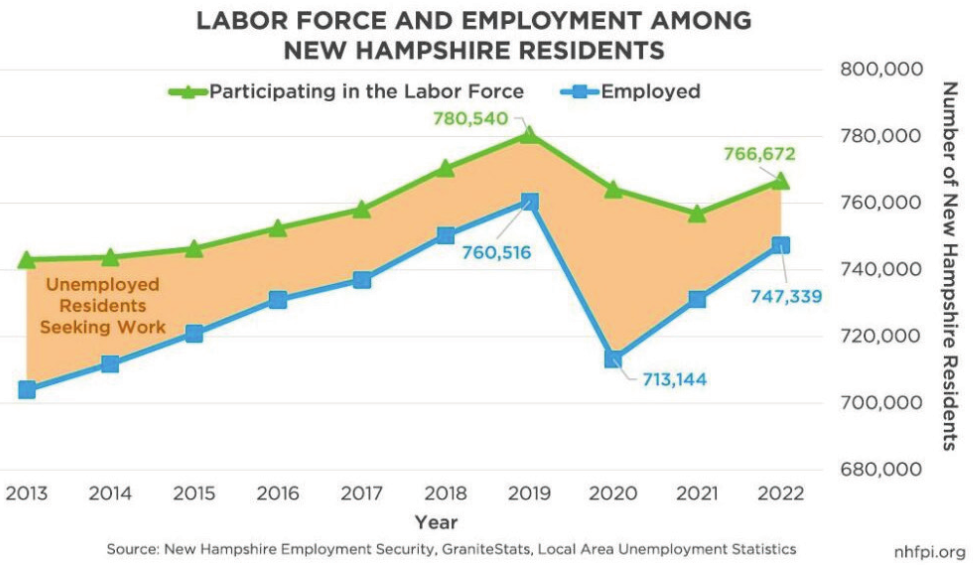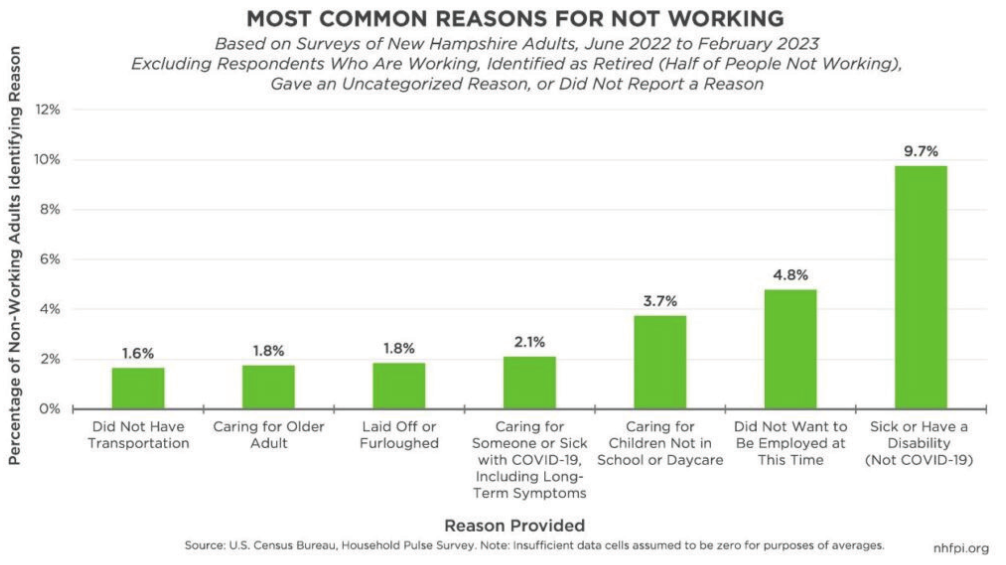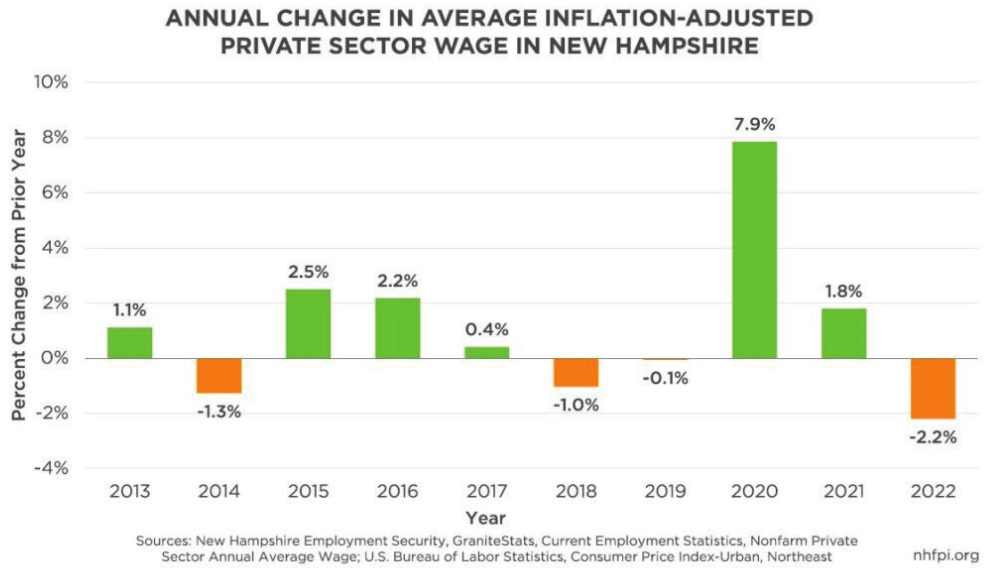Economic challenges still constrain NH’s workforce
New Hampshire’s residents and economy have experienced a tumultuous three years since the Covid-19 pandemic reached the state. However, while certain key aspects of the economy have changed, New Hampshire continues to face the same fundamental challenges to its economy that it encountered before the pandemic.
A workforce shortage is slowing the economy’s growth, with a very limited and expensive housing supply and long-term demographic factors contributing to a lack of workforce growth. Students leaving the state for opportunities in higher education elsewhere and parents having difficulty finding child care, or care for older adults in need of assistance, also limits the number of Granite Staters participating in the workforce.
While these same constraints existed in 2019, the effects of these constraints continue to be exacerbated by the pandemic three years later. Although average wages have risen in response to these workforce constraints, higher inflation levels have eroded wage gains since the start of the pandemic, causing individuals and families to increasingly struggle to afford rising housing, child care and other costs.

Workforce smaller than before pandemic
Three years after the pandemic’s start, the labor force remains smaller than it did immediately before it began. In February 2020, the number of New Hampshire residents working or looking for work, or the equivalent of those employed plus people who were unemployed and looking for work, totaled a seasonally adjusted 777,800 residents. Three years later, in February 2023, an estimated 770,000 residents were in the labor force. This decline of about 7,800 fewer potential employees occurred as the state’s population increased by an estimated 17,700 people from April 2020 to July 2022.
However, February 2020 was not the peak of the labor force size to date. The summer of 2019 had a larger estimated labor force, both before and after seasonal adjustments, and growth in New Hampshire’s labor force had generally been tepid in the years following the Great Recession. Only when wages, particularly for workers with lower incomes, grew starting in 2016 with the economy’s overall recovery did labor force participation start to increase more substantially.
Annual averages over the previous 10 years suggest that the size of the labor force likely limited employment growth as the number of unemployed residents declined. In 2019, the average number of unemployed residents, or those not employed but engaged in the labor force because they were actively looking for work, was approximately 20,000 people, or an average unemployment rate of about 2.6 percent. The number of unemployed residents expanded substantially during the pandemic as employment declined faster than people left the labor force, and average employment was lower than in any year since 2014.
Employment has rebounded, but in 2022 the average number of unemployed residents dropped to about 19,300, reflecting an unemployment rate of 2.5 percent. As in 2019, this low number of unemployed residents reflected a workforce shortage that likely constrained economic growth.
However, a key difference from 2019 is that both employment and labor force levels are lower than before the pandemic. The number of employed residents and the number of labor force participants were lower in 2022, on average, than they were in 2018. The seasonally adjusted preliminary February 2023 figures remained below the 2018 annual averages for labor force size and for the number of employed Granite Staters.
While the labor force remains smaller, 2021 was potentially a pandemic-era low point, as the number of participants and total employment increased between 2021 and 2022.

Reasons for staying out
Although each individual faces a unique set of circumstances that may limit their labor force participation, survey data can provide some insight into the reasons people are leaving, or have not yet rejoined, the labor force. The rationales for remaining out of the workforce are in flux with the waning of the Covid-19 pandemic and the disruptions caused by its threats to public health.
Since mid-2020, the U.S. Census Bureau has asked residents a series of survey questions related to the impacts of the pandemic on approximately a monthly basis. The bureau asks about employment, including why people may not be working at the time of the survey. About half of the adult respondents in New Hampshire who were not employed identified that they were retired. While all less numerous than retirement, several other key reasons were common among the remaining adults not currently working.
Based on data collected from June 2022 to February 2023, an average of 9.7 percent of New Hampshire adults (or about 38,000) who were not working identified being sick with an ailment other than Covid-19 or a disability at the time of the survey. These illnesses could have been temporary, and the monthly survey data suggests that more people reported this rationale for not working in the fall and winter months. The survey asks about work for pay or profit spanning the prior seven days, so illnesses must have been severe enough to keep an employed person from working for an extended period. Many respondents may have a long-term ailment or disability keeping them from working.
The next most common reason provided was not wanting to be employed at the time of the survey. Not wanting to be employed could be due to a variety of factors, including causes identified by others as a reason to refrain from working; for example, someone could answer that they do not want to be employed because they are choosing not to work while raising children, whereas others may prefer to work but are raising children who would otherwise be in school or a child care setting and cannot leave them to participate in employment.
Caring for children who are not in school or day care was the third-most selected survey option, with an average of 3.7 percent of non-working adults (or about 15,000 people) across this time period. The lack of availability and affordability of child care, as well as temporary disruptions associated with illness or staffing shortages at child care agencies, can be significant barriers to the consistent employment of parents for many Granite State families.
In 2021, the price of center-based child care for a toddler in New Hampshire was $13,151, and center-based care for an infant averaged about $14,245. Those totals bring the cost for a family to pay for center-based child care for an infant and a toddler together to 21 percent of the 2017-2021 median income for married parents, or to 45 percent of a two-parent household in which both parents are working full time for wages at the 25th percentile of hourly work incomes in New Hampshire. Paying for child care for just one toddler would equal a third of the median income of a single female-headed household in New Hampshire. Additionally, a state report from 2021 estimated that about 50 percent of child care need was unmet by formal settings in October 2020.
The following most commonly cited reason for not working was being sick, or caring for someone who was sick, with Covid-19. In the most recent months of data, the question prompt explicitly included long-term symptoms. The average of 2.1 percent (about 8,000 people) identifying this reason for staying out of the workforce over this time period appeared to decline between June 2022 and February 2023. The workforce impacts of long-term Covid-19 symptoms are not fully understood. Some researchers estimate hundreds of thousands of workers nationally may be out of the labor force due to long-term Covid-19 symptoms, while others indicate the figure may be as high as 4 million people.
Other reasons identified for not working include being laid off or furloughed (averaging 1.8 percent), caring for an older adult (1.8 percent), and not having transportation to work (1.6 percent).
While this data offers insight on specific barriers to workforce participation New Hampshire residents face, fully half of the non-working adult respondents identified they were out of the labor force because they were retired, by far the largest of any group (about 204,000 people, or 52.2 percent of the non-working adult population). Even without the impacts of the pandemic, New Hampshire’s labor force was likely to be constrained by demographics, as more than 250,000 New Hampshire residents are either within 10 years of the traditional retirement age of 65, or were less than five years older than that benchmark. These adults were likely to leave the labor force in significant numbers over the 10 years following 2019 regardless of the pandemic. However, Covid-19 and its impacts appear to have prompted more residents aged 55 years and older to say they were not looking for work.
Additionally, this survey data does not capture the reasons people who do not live in New Hampshire, but might seek to in different circumstances, are not in the state’s labor force. The severe lack of housing in New Hampshire reduces the ability of individuals and families to move to the state, including to pursue job opportunities.
The affordability of public higher education in New Hampshire may also be a factor in retaining potential members of the workforce. Out of all 50 states, New Hampshire had the second highest percentage of recent high school graduates attending four-year colleges in fall 2020.

Wages and the pandemic
New Hampshire’s key pre-pandemic workforce and economic challenges remain, and several of these challenges, such as the housing shortage, have been substantially exacerbated by the pandemic. Certain other issues, such as inflation, were not central to New Hampshire’s pre-pandemic economic challenges but are now risks to the economy. Widespread inflation during the rapid and uneven recovery from the pandemic has impacted the purchasing power of New Hampshire workers.
Growth in inflation-adjusted average hourly pay in New Hampshire, across all jobs in the state, had been relatively flat in the years prior to the pandemic. Between 2013 and 2019, three years of inflation-adjusted average wage growth had been above 1 percent (2013, 2015 and 2016), while for two years (2014 and 2018) wages slipped below inflation by at least 1 percent, and two years (2017 and 2019) had less than a 1 percent change from the previous year in either direction.
While the average wage was relatively stable during this time period, the overall recovery from the Great Recession of 2007-2009 in New Hampshire produced much more robust wage gains for higher-income workers than for those with lower incomes compared to the period just before the Great Recession.
In 2020, average wages rose substantially. This rise was due to people leaving the labor force or switching industries in response to the pandemic, reducing the labor supply in specific industries, and because many workers with lower incomes were laid off, reducing the number of employees in the economy earning low wages. In contrast, higher-income workers were more likely to retain their positions, pulling the average wage up even while nearly half of Granite Staters lost employment income in the first four months of the pandemic.
Inflation-adjusted wage growth moderated in 2021 relative to 2020, and inflation accelerated in early 2022 due in large part to geopolitical impacts on energy prices. That acceleration eroded the wage gains many workers made in 2020 and 2021, as the costs of goods and services in the economy rose faster than income for many workers. While hardship associated with high prices has eased somewhat, about one in every three New Hampshire adults reported paying for usual household expenses had been somewhat or very difficult in the prior seven days in survey data collected during early March 2023.
Looking ahead
The impacts of the pandemic continue, but many of those impacts may continue to wane as the post-pandemic economic patterns become more permanent. However, the ongoing constraints on New Hampshire’s economy and labor force that existed prior to the pandemic remain. A lack of access to affordable housing and child care likely directly holds back economic growth and enhancements to the well-being of Granite State families.
In the long term, robust educational opportunities are crucial to helping ensure and retain a sufficient future workforce. Health-related supports, such as long-term care for older adults and enhanced methods of addressing longterm health and disability challenges, also provide opportunities to aid labor force participation. Targeted and intentional policy interventions can be deployed to help support an equitable and inclusive workforce and economy.
Phil Sletten is research director of the NH Fiscal Policy Institute, which is sharing this article with the partners in the Granite State News Collaborative. NHFPI is an independent nonprofit organization that explores, develops and promotes public policies that foster economic opportunity and prosperity for all New Hampshire residents. For more information, visit nhfpi.org